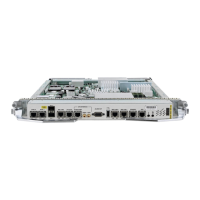local-traffic default encapsulation
To enable Connectivity Fault Management (CFM) to identify a range of VLAN IDs that are to be used as the
default for sourcing CFM packets from the interface, use the local-traffic default encapsulation command
in the subinterface configuration mode. To return to the default behavior, use the no form of this command.
local-traffic default encapsulation {dot1q vlan-id| dot1q vlan-id second-dot1q vlan-id| dot1ad vlan-id|
dot1ad vlan-id dot1q vlan-id}
no local-traffic default encapsulation {dot1q vlan-id| dot1q vlan-id second-dot1q vlan-id| dot1ad vlan-id|
dot1ad vlan-id dot1q vlan-id}
Syntax Description
Indicates that the IEEE 802.1q standard encapsulation type is used.dot1q
Indicates that the IEEE 802.1q encapsulation is used.second-dot1q
Indicates that the IEEE 802.1ad provider bridges encapsulation type is used.dot1ad
Specifies the VLAN ID as an integer. The range is 1 to 4094. A hyphen separates
the starting and ending VLAN ID values that are used when defining a range of
VLAN IDs.
vlan-id
Command Default
Lowest numbered VLAN ID is chosen.
Command Modes
Subinterface configuration
Command History
ModificationRelease
This command was introduced.Release 3.9.1
Usage Guidelines
To use this command, you must be in a user group associated with a task group that includes appropriate task
IDs. If the user group assignment is preventing you from using a command, contact your AAA administrator
for assistance.
The tag stack configured by the local-traffic default encapsulation command must match the encapsulation
specified for this interface in the encapsulation command.
For packets that are sent as responses to incoming packets, the encapsulation that is to be used may be derived
from the incoming packet. This command determines the encapsulation to use when this is not the case.
Cisco ASR 9000 Series Aggregation Services Router VPN and Ethernet Services Command Reference, Release
6.1.x
26
Ethernet Interfaces Commands
local-traffic default encapsulation

